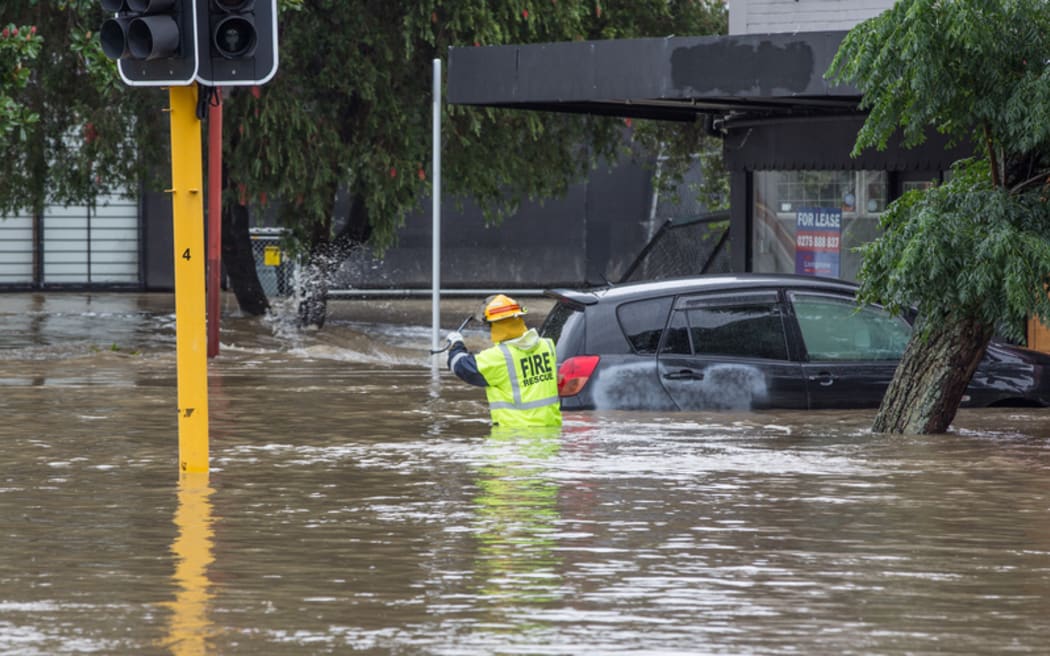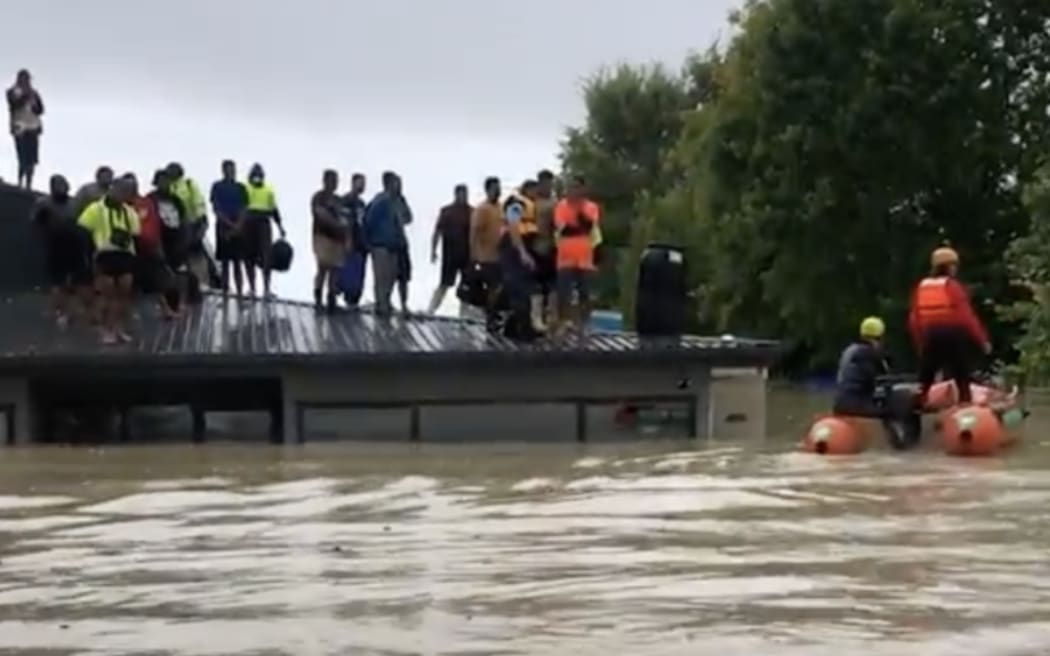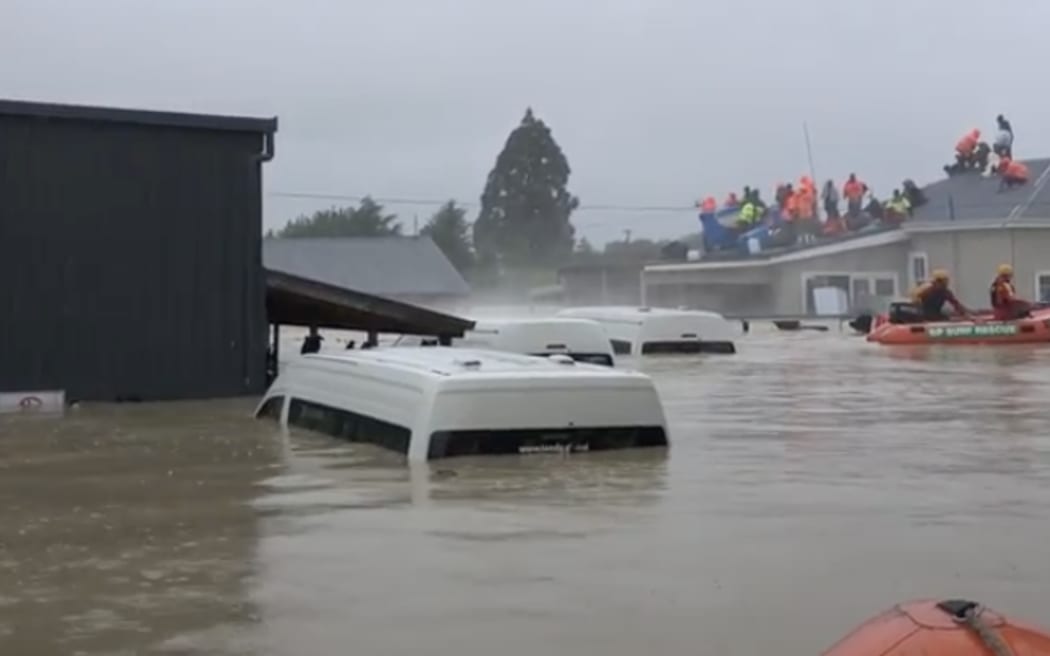
Only after Gabrielle did Fire and Emergency begin providing training for its first crews in 'swift-water' rescues. (File pic) Photo: RNZ / Cole Eastham-Farrelly
The country is scrambling to deal with flood rescues in the face of growing threats fuelled by climate change.
After New South Wales suffered extreme floods last year, the state government responded with over A$200 million for new rescue boats, high-clearance trucks and 2300 more trained rescuers.
RNZ has asked the government if it has any plans for anything like that here following Cyclone Gabrielle and the Auckland Anniversary floods.
A spokesperson for the Emergency Management Minister Kieran McAnulty put out a 17-line statement that did not mention funding, boats or other resources, but said a framework was being developed "for how we work together" and to "make sure the right training and equipment is used during emergencies".
Years of warnings crystallised when hundreds of people had to be saved by boats from rooftops and rapidly rising floodwaters during the two emergencies in the wettest of summers; it was unprecedented, but no surprise. Rescuers noted they had been experiencing a ramping-up of flood demands for the last two years.
"NEMA recognises that floods are New Zealand's number one hazard," the National Emergency Management Agency told RNZ this week.
But nationally, the rescue response preparation has been slow, patchy, and tangled up in wrangles over who pays the bills.
"Deep down, most of us will be happy to admit, we've had a couple of warm-ups and we've had a couple of near-misses," said firefighter Jamie Keenan, who was at a Napier command post during Gabrielle. He was president of the Hawke's Bay firefighters union branch and has been through four floods.
"It's probably time to get a bit more professional about the way we do things."
NEMA has begun working with other agencies on what it needed in training, equipment and deployment for floods. It put no timeframe on getting results.
Only after Gabrielle did Fire and Emergency (FENZ) begin providing training for its first crews in 'swift-water' rescues. It had five 12-person teams and a sixth finishing training soon. This was the basic level of training in a tiered scheme.
"Swift water training... never really got traction until the first Auckland flood [in January]," Keenan said. "And then because it happened to one of the major cities, all of a sudden, there was this impetus to get it done... We've talked about it to that point, but we hadn't actually got the trained boots on the ground."
The Coastguard has had a swift-water rescue team since 2011, but only one of them, in North Canterbury - although it told RNZ it was looking to expand on this.
Surf Life Saving NZ (SLSNZ) is the most developed, having trained 100 rescuers and 40 flood rescue boat drivers since 2021.
But it was hobbled by a lack of kit and a fractured system, a spokesperson said. After both the 2021 Kumeū floods and now Gabrielle, it had struggled to recoup costs from Civil Defence (CDEM) or FENZ.
"The lack of agreements and forward planning between CDEM groups and FENZ poses a risk to all three agencies," national search and rescue manager Allan Mundy said in an internal update in December.
Surf Life Saving had been identified as best positioned to lead flood rescues by boat in a Search and Rescue study of resource gaps and capability, he said.
However, "interagency cooperation currently between the three agencies [with FENZ and Civil Defence] is ad-hoc to non-existent".
"Appropriate communication channels between the three agencies are non-existent, so the risk of deploying the wrong personnel is high."

Surf lifeguards saving stranded Hawke's Bay residents during Cyclone Gabrielle. Photo: SUPPLIED
Asked about that this week, Mundy told RNZ things were improving, and they had been working closely with FENZ for 18 months.
Yet it was clearly far from a well-oiled machine. If lifeguards rescued someone, police paid them back under a cost-recovery deal; but if they boated in to check on someone in a flooded house, that was "welfare" and they had to ask Civil Defence to cover the bill - and had no cost-recovery deal with it (or with FENZ) , Mundy said.
"There's a gap between who's calling the shots now. All we've been told is to go and rescue lives or go and save people, and we'd hope that the 'top table' are actually working out, 'OK, we've got this now.'"
UK experience
The threat has been clear for a long time; in 2007, after 48,000 homes were inundated in the UK, an inquiry panel put the flood threat "on a par with things like terrorism".
The warnings in Britain then rang bells now here, after Gabrielle.
"There were some sites with critical infrastructure on them; power stations, for example, which came extremely close to flooding," the UK inquiry found.
"Other key advice included a call to clarify which agency should be responsible for rescuing those caught in floods and ensuring its personnel have the right training and equipment," the Guardian reported.
Surf Life Saving has led the calls here for more and better, compared with FENZ's annual report and strategy documents that talk in general terms of more flooding due to climate change, with few details of what it plans to do about it.
"SLSNZ believes we need to prepare for future flood events that require a large-scale response with appropriately resourced and trained flood response squads," the December update said.
The contrast continued in NSW. After its floods, it put $12m into boosting volunteerism as part of rescue capability.
Here, meanwhile, Surf Life Saving was locked into spending its first-ever major government funding in 2020 on beach patrol work - it cannot go to flood rescues - and faced sinking large sums into fixing its storm-damaged clubhouses.
Mundy said the organisation was looking to copy Australia, the UK and US, and the government agencies should, too.
"We're not spending money reinventing wheels, we're looking at what works, and we're quite confident we know what we need."
What they needed was supplies of flood-rescue gear at 60 clubhouses around the country, including drysuits to resist contaminated floodwaters. However, there was no easy avenue to get government funding, Mundy said.
Could NEMA's new look at resourcing fix that? It encompassed FENZ and Surf Life Saving, and also the Search and Rescue Secretariat , the Coastguard and Land Search and Rescue.
When RNZ asked Search and Rescue for details of the water capability project around flood rescues, it issued a brief statement, stating that in emergencies it was usually Civil Defence authorities that gave tasks to response agencies.
It added it was working with the other agencies to "develop a framework for how they work together during civil emergency events".

Surf lifesaving crews used inflatable rescue boats to help evacuate stranded Hawke's Bay residents during Cyclone Gabrielle. Photo: SUPPLIED
More professional response will 'cost'
Keenan said getting more professional would have to encompass training, reviews, gear and regular funding.
"Just because we've always done it, and we've managed to get through, doesn't mean when you want a more professional service, it doesn't cost."
Emergencies had caught up on fire demands, and "we've been sort of caught short on the wet flank".
FENZ said its new swift water rescue teams, which have been doing similar training as Surf Life Saving's, should be fully equipped and "up and running by mid-July".
One team will be based in Napier-Hastings, and also cover Manawatu. Tai Rāwhiti will be covered by a team in Ngā Tai Ki Te Puku, Bay of Plenty.
Keenan noted regular firefighters were dissuaded from going more than waist-deep, and especially not in their heavy kit - but "we do push the limit".
They also were not meant to drive fire trucks in more than 100mm of water. Several trucks broke down in the Auckland floods when their low air intakes sucked up water.
"A few more customised trucks for the risks within certain regions might be better," Keenan said.
The Coastguard was looking to boost its capabilities, including for fresh-water rescue, it told RNZ.
It would draw on the "test-bed" experience of the North Canterbury swift-water team "to look at where and how it should grow to fill other areas of need".
Since the team was set up in 2011, a quarter of its operations had been swift-water ones, covering the Rakaia River to the Hurunui and inland to the Southern Alps.
"Significant investment is presently underway to strengthen this team's capability and purchase specialist equipment to enhance crew safety, operational management and response capability," the Coastguard said in a statement.
Aerial flood rescue was not covered in this story.
Minister McAnulty's statement listed the essential service infrastructure upgrades the government has committed to since Gabrielle. It did not say how the framework that was being developed would resource the rescuers, but said it "will protect equipment from damage and most importantly protect rescuers from harm".


